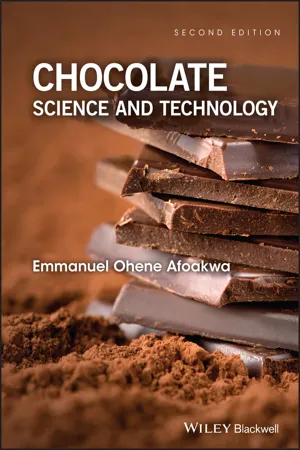
- English
- ePUB (mobile friendly)
- Available on iOS & Android
Chocolate Science and Technology
About This Book
This second edition provides information on recent advances in the science and technology of chocolate manufacture and the entire international cocoa industry. It provides detailed review on a wide range of topics including cocoa production, cocoa and chocolate manufacturing operations, sensory perception of chocolate quality, flavour release and perception, sugar replacement and alternative sweetening solutions in chocolate production, industrial manufacture of sugar-free chocolates as well as the nutrition and health benefits of cocoa and chocolate consumption.
The topics cover modern cocoa cultivation and production practices with special attention on cocoa bean composition, genotypic variations in the bean, post-harvest pre-treatments, fermentation and drying processes, and the biochemical basis of these operations. The scientific principles behind industrial chocolate manufacture are outlined with detailed explanations of the various stages of chocolate manufacturing including mixing, refining, conching and tempering. Other topics covered include the chemistry of flavour formation and development during cocoa processing and chocolate manufacture; volatile flavour compounds and their characteristics and identification; sensory descriptions and character; and flavour release and perception in chocolate. The nutritional and health benefits of cocoa and chocolate consumption as well as the application of HACCP and other food safety management systems such as ISO 22, 000 in the chocolate processing industry are also addressed. Additionally, detailed research on the influence of different raw materials and processing operations on the flavour and other quality characteristics of chocolates have been provided with scope for process optimization and improvement.
The book is intended to be a desk reference for all those engaged in the business of making and using chocolate worldwide; confectionery and chocolate scientists in industry and academia; students and practising food scientists and technologists; nutritionists and other health professionals; and libraries of institutions where agriculture, food science and nutrition is studied and researched.
Frequently asked questions
Information
Chapter 1
History, origin and taxonomy of cocoa
1.1 Introduction
1.2 History of cocoa
Table of contents
- Cover
- Title Page
- Copyright
- Table of Contents
- Dedication
- Preface
- Acknowledgements
- About the author
- Chapter 1: History, origin and taxonomy of cocoa
- Chapter 2: World cocoa production, processing and chocolate consumption pattern
- Chapter 3: Traditional and modern cocoa cultivation practices
- Chapter 4: Cocoa diseases and pests and their effects on chocolate quality
- Chapter 5: Cocoa bean composition and chocolate flavour development
- Chapter 6: Cocoa processing technology
- Chapter 7: Industrial chocolate manufacture – processes and factors influencing quality
- Chapter 8: The chemistry of flavour development during cocoa processing and chocolate manufacture
- Chapter 9: Alternative sweetening and bulking solutions in chocolate manufacture
- Chapter 10: Sensory character and flavour perception of chocolates
- Chapter 11: Nutritional and health benefits of cocoa and chocolate consumption
- Chapter 12: Processing effects on the rheological, textural and melting properties during chocolate manufacture
- Chapter 13: Tempering behaviour during chocolate manufacture: Effects of varying product matrices
- Chapter 14: Tempering and fat crystallization effects on chocolate quality
- Chapter 15: Fat bloom formation and development in chocolates
- Chapter 16: Matrix effects on flavour volatiles character and release in chocolates
- Chapter 17: Process optimization and product quality characteristics during sugar-free chocolate manufacture
- Chapter 18: Food safety management systems in chocolate processing
- Chapter 19: Application of ISO 22000 and hazard analysis and critical control points (HACCP) in chocolate processing
- Chapter 20: Conclusions and industrial applications
- References
- Abbreviations
- Acronyms and websites of organizations related to the cocoa and chocolate industry
- Glossary of cocoa and chocolate terminologies
- Index
- End User License Agreement